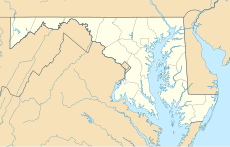
Minot Air Force Base is a United States Air Force (USAF) installation in Ward County, North Dakota, thirteen miles (20 km) north of the city of Minot via U.S. Route 83. In the 2020 census, the base was counted as a CDP with a total population of 5,017, down from 5,521 in 2010. Minot AFB is the home of two major wings: the 5th Bomb Wing and 91st Missile Wing, both of the Air Force Global Strike Command (AFGSC).

The Boeing B-47 Stratojet is a retired American long-range, six-engined, turbojet-powered strategic bomber designed to fly at high subsonic speed and at high altitude to avoid enemy interceptor aircraft. The primary mission of the B-47 was as a nuclear bomber capable of striking targets within the Soviet Union.
This is a list of aviation-related events from 1957.
Sandia Base was the principal nuclear weapons installation of the United States Department of Defense from 1946 to 1971. It was located on the southeastern edge of Albuquerque, New Mexico. For 25 years, the top-secret Sandia Base and its subsidiary installation, Manzano Base, carried on the atomic weapons research, development, design, testing, and training commenced by the Manhattan Project during World War II. Fabrication, assembly, and storage of nuclear weapons was also done at Sandia Base. The base played a key role in the United States nuclear deterrence capability during the Cold War. In 1971 it was merged into Kirtland Air Force Base.
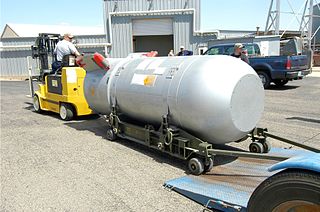
The Mk/B53 was a high-yield bunker buster thermonuclear weapon developed by the United States during the Cold War. Deployed on Strategic Air Command bombers, the B53, with a yield of 9 megatons, was the most powerful weapon in the U.S. nuclear arsenal after the last B41 nuclear bombs were retired in 1976.

The B28, originally Mark 28, was a thermonuclear bomb carried by U.S. tactical fighter bombers, attack aircraft and bomber aircraft. From 1962 to 1972 under the NATO nuclear weapons sharing program, American B28s also equipped six Europe-based Canadian CF-104 squadrons known as the RCAF Nuclear Strike Force. It was also supplied for delivery by UK-based Royal Air Force Valiant and Canberra aircraft assigned to NATO under the command of SACEUR. In addition, certain U.S. Navy carrier based attack aircraft such as the A3D Skywarrior, A4D Skyhawk, and A3J Vigilante were equipped to carry the B28.
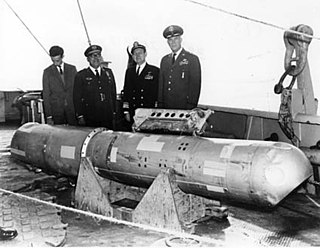
The 1966 Palomares B-52 crash, also called the Palomares incident, occurred on 17 January 1966, when a B-52G bomber of the United States Air Force's Strategic Air Command collided with a KC-135 tanker during mid-air refueling at 31,000 feet (9,450 m) over the Mediterranean Sea, off the coast of Spain. The KC-135 was destroyed when its fuel load ignited, killing all four crew members. The B-52G broke apart, killing three of the seven crew members aboard.

Sometime after midnight on 14 February 1950, a Convair B-36B, United States Air Force Serial Number 44-92075 assigned to the US 7th Bombardment Wing, Heavy at Carswell Air Force Base in Texas, crashed in northwestern British Columbia on Mount Kologet after jettisoning a Mark 4 nuclear bomb. This was the first such nuclear weapon loss in history. The B-36B had been en route from Eielson Air Force Base near Fairbanks, Alaska, to Carswell AFB, more than 3,000 miles southeast, on a mission that included a simulated nuclear attack on San Francisco.

The 5th Bomb Wing is a United States Air Force unit assigned to Air Force Global Strike Command's Eighth Air Force. It is stationed at Minot Air Force Base, North Dakota. The wing is also the host unit at Minot. The 5 BW is one of only two active duty Boeing B-52H Stratofortress wings in the United States Air Force, the other being the 2nd Bomb Wing at Barksdale Air Force Base, Louisiana. Also, stationed at Barksdale Air Force Base, and operating the B-52H is a third unit, the 307th Bomb Wing, which is part of the Air Force Reserve Command.
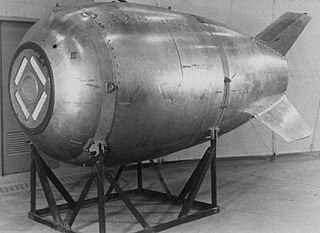
The Mark 4 nuclear bomb was an American implosion-type nuclear bomb based on the earlier Mark 3 Fat Man design, used in the Trinity test and the bombing of Nagasaki. With the Mark 3 needing each individual component to be hand-assembled by only highly trained technicians under closely controlled conditions, the purpose of the Mark 4 was to produce an atomic weapon as a practical piece of ordnance. The Mark 4 Mod 0 entered the stockpile starting March 19, 1949 and was in use until 1953. With over 500 units procured, the Mark 4 was the first mass-produced nuclear weapon.

On 21 January 1968, an aircraft accident, sometimes known as the Thule affair or Thule accident, involving a United States Air Force (USAF) B-52 bomber occurred near Thule Air Base in the Danish territory of Greenland. The aircraft was carrying four B28FI thermonuclear bombs on a Cold War "Chrome Dome" alert mission over Baffin Bay when a cabin fire forced the crew to abandon the aircraft before they could carry out an emergency landing at Thule Air Base. Six crew members ejected safely, but one who did not have an ejection seat was killed while trying to bail out. The bomber crashed onto sea ice in North Star Bay, Greenland, causing the conventional explosives aboard to detonate and the nuclear payload to rupture and disperse, resulting in radioactive contamination of the area.
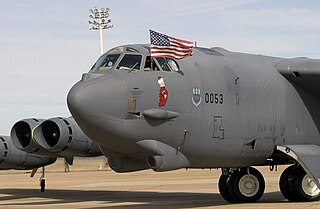
The 2008 Guam B-52 crash was a fatal crash of a United States Air Force (USAF) B-52H Stratofortress on 21 July 2008. The aircraft, operating out of Andersen Air Force Base, crashed into the Pacific Ocean during a training flight approximately 30 nautical miles (56 km) northwest of Apra Harbor, Guam. The training flight was to include participation in a local municipal celebration of Liberation Day in Hagåtña. All six crew members aboard the aircraft were killed and the aircraft was destroyed.

The Boeing B-52 Stratofortress is an American long-range, subsonic, jet-powered strategic bomber. The B-52 was designed and built by Boeing, which has continued to provide support and upgrades. It has been operated by the United States Air Force (USAF) since the 1950s, and NASA for over 40 years. The bomber can carry up to 70,000 pounds (32,000 kg) of weapons and has a typical combat range of around 8,800 miles (14,200 km) without aerial refueling.

Operation Chrome Dome was a United States Air Force Cold War-era mission from 1961 to 1968 in which B-52 strategic bomber aircraft armed with thermonuclear weapons remained on continuous airborne alert, flying routes that put them in positions to attack targets in the Soviet Union if they were ordered to do so. The exact routes varied by year, but in general there were routes that went to positions over the Canadian arctic, Alaska, Greenland, and the Mediterranean Sea. Many American Air Force Bases in the 1960s allocated at least one bomber crew to "Chrome Dome" duty on a regular basis, and many other bases, including foreign bases, were involved in the refueling operations. Over the years the mission involved overflights of American, Canadian, Danish (Greenland), and Spanish territory, among others. The goal of "Chrome Dome" was to keep a number of nuclear-armed aircraft in a position to help guaranteed nuclear retaliation against the Soviet Union in the event that the latter was somehow able to destroy the majority of US nuclear weapons still on the ground, while also ensuring that Strategic Air Command bomber crews had experience with airborne alert procedures so that, in the event of heightened concern, the number of patrolling bombers could be increased dramatically. Several high-profile nuclear accidents were associated with the "Chrome Dome" program, including the accidental release of nuclear weapons on foreign territory, and it was shut down in the wake of one such accident in 1968.

The 1961 Goldsboro B-52 crash was an accident that occurred near Goldsboro, North Carolina, United States, on 24 January 1961. A Boeing B-52 Stratofortress carrying two 3.8-megaton Mark 39 nuclear bombs broke up in mid-air, dropping its nuclear payload in the process. The pilot in command, Walter Scott Tulloch, ordered the crew to eject at 9,000 ft (2,700 m). Five crewmen successfully ejected or bailed out of the aircraft and landed safely; another ejected, but did not survive the landing, and two died in the crash. Information declassified since 2013 has showed that one of the bombs was judged by nuclear weapons engineers at the time to have been only one safety switch away from detonation, and that it was "credible" to imagine conditions under which it could have detonated.

The 69th Bomb Squadron is an active United States Air Force unit. After being inactivated on 31 December 1993, it was reactivated on 3 September 2009 at Minot Air Force Base, and assigned to the 5th Bomb Wing. The squadron operates Boeing B-52H Stratofortress aircraft.

On 24 January 1963 a United States Air Force Boeing B-52C Stratofortress with nine crew members on board lost its vertical stabilizer due to buffeting stresses during turbulence at low altitude and crashed on Elephant Mountain in Piscataquis County, Maine, United States, six miles (9.7 km) from Greenville. The pilot and the navigator survived the accident.

A nuclear close call is an incident that might have led to at least one unintended nuclear detonation or explosion, but did not. These incidents typically involve a perceived imminent threat to a nuclear-armed country which could lead to retaliatory strikes against the perceived aggressor. The damage caused by international nuclear exchange is not necessarily limited to the participating countries, as the hypothesized rapid climate change associated with even small-scale regional nuclear war could threaten food production worldwide—a scenario known as nuclear famine. There have also been a number of accidents involving nuclear weapons, such as crashes of nuclear armed aircraft.

